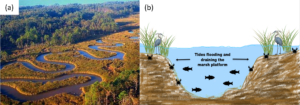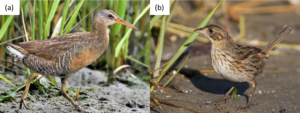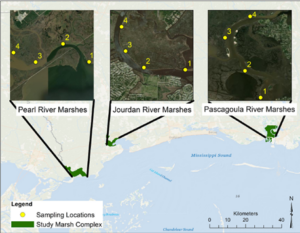Tidal marshes: What are they?

I am sure that the word ‘marsh’ rings a bell! Briefly, a marsh is a wetland dominated by grasses and often found at the edges of lakes, streams and estuaries. Marshes form a transition between land and water ecosystems, and there are different types of marshes depending on their location and salinity. A tidal marsh (Fig. 1) is one type of marsh forming a finger-like network that is subject to constant flooding and draining by tides, which provides a unique environment for a wide variety of plants and animals to thrive. Globally, tidal marshes cover approximately 45,000 km2, an area 15 times smaller than the state of Texas. Despite their small global coverage, tidal marshes are extremely valuable ecosystems, providing numerous ecosystem services. They contribute to climate resilience through their carbon storage capacity; they provide protection against storms, prevent shoreline erosion and filter nutrients. More importantly, they are among the most productive habitats on the planet, providing food, shelter and nursery areas for a wide variety of fish, shellfish and birds. One of the greatest threats to tidal marshes and the biodiversity they support is the increasing urbanization and development in the coastal areas surrounding them, leading to pollution and especially microplastic pollution.
Microplastic pollution: A storm brewing
With the increased production and use of plastic since the beginning of the twentieth century, plastic has become the most prevalent type of marine debris found in the ocean. Around 4-13 million metric tons of this plastic enters the ocean every year and that number is projected to increase. Although the large plastics can cause physical damage to marine animals and even cause death, it’s their degradation into smaller pieces called microplastics that pose a bigger environmental threat. Microplastics are microscopic pieces of plastic less than 5 mm in length on average, that get transported via ocean currents, winds and tides and accumulate in coastal ecosystems like tidal marshes. The degradation of larger plastics into microplastics in tidal marshes occurs quickly and it is becoming a growing concern because the microplastics are often mistaken as food sources and easily ingested by marsh birds, leading to mortality. With the quantities of microplastics being among the highest in the Gulf of Mexico, the researchers in this study looked at microplastic distribution in the tidal marsh sediments of Mississippi (northern Gulf of Mexico) and determined its possible ingestion by two resident tidal marsh birds: Clapper Rails (Fig. 2a) and Seaside Sparrows (Fig. 2b). They also compared the amount of microplastics ingested by each bird type, which can depend on their feeding habits.

Conducting the experiment

First, the researchers collected sediment samples from three river-dominated tidal marshes in the Mississippi: The Pascagoula, Jourdan and Pearl Rivers (Fig. 3). The Pascagoula River has a population density of 29 persons/km2; The Jourdan River has a population density of 218 persons/km2; The Pearl River has a population density of 7 persons/km2. Three sediment samples from each of the four sampling locations at each of the three tidal marshes (36 samples total) were collected, dried in a drying oven, and weighed. Each sample was then sieved through different sizes of sieves to separate the larger fragments and the smaller fragments. Once separated, the sample was rinsed and then observed under a microscope, where the amount of microplastics was counted in pieces/g.
The second portion of the experiment involved the capture of the two marsh birds to analyze their stomach contents. Three Clapper Rails and three Seaside Sparrows were captured at each of the four sampling locations in each tidal marsh using nets. To attract them to the nets, the researchers played previously recorded Clapper Rails and Seaside Sparrow calls from speakers located around the nets. Once captured, the birds were safely removed from the nets and the researchers carefully inserted a lavage tube into the bird’s throat to flush its stomach contents with water. The birds were then inverted over a collection tray to collect the contents, and then safely released in the same area where they were caught. Each bird’s stomach content was then dried and analyzed for microplastics under a microscope.
An alarming finding: 69-83% of the marsh bird’s stomach samples had microplastics!
The researchers detected microplastics in 64% of the sediment samples they collected from all three tidal marshes. 98% of the samples were made up of microplastic fibers, which are usually found in clothes! Among the stomach flush samples collected, microplastics were detected in 83% of the Clapper Rails and 69% of the Seaside Sparrows’ stomach contents. Again, fibers were the dominant type of microplastics detected at 99% in Clapper Rails and 98% in Seaside Sparrows. Overall, a greater amount of microplastics were detected in Clapper Rails, possibly due to their feeding strategy. Clapper Rails usually probe into the muddy marsh sediments to harvest their preys, feeding mostly on fiddler crabs which are known to ingest microplastics and hence accumulate them in their organs. Hence, the microplastic intake of Clapper Rails may be larger due to consuming preys which themselves have ingested microplastics. Seaside Sparrows, on the other hand, generally glean on the surface of the marsh platform, feeding on insects, which would explain the fewer microplastics found in their stomachs.
Although this study provided the first evidence of microplastic ingestion by resident tidal marsh birds, the researchers acknowledge that additional work is needed to determine the lasting effects of microplastic ingestion on the birds. Additional work is also necessary to understand how microplastics are transferred though the tidal marsh food webs and its ultimate effect, not only on the environment but on human health. The potential hazardous effects on humans can include infertility, obesity and cancer. The United Nations Environment Program anticipates that plastic biomass will exceed fish biomass in the ocean by 2050, which is why there is an urgent need to reduce microplastics pollution and movement in the marine environment.
Born and raised on Mauritius Island in the Indian Ocean, I came to the United States in 2015 as a Fulbright scholar to pursue a Masters degree in Marine Science at North Carolina State University. After completing my Masters degree, I stayed at NC State University where I complete my Ph.D., working in parallel as an ORISE fellow at the U.S. EPA. My research focused on two blue carbon habitats: seagrass meadows and salt marshes. I applied different methods including satellite remote sensing and machine learning to fill the current knowledge gaps in the areal extent and carbon storage capacity of these important blue carbon sinks for better monitoring and management of such ecosystems in the face of climate and anthropogenic pressures. I am now an Associate with Silvestrum Climate Associates, developing blue carbon restoration and conservation projects. When not sciencing, I enjoy my daily yoga routines, taking care of my house plants, watching f.r.i.e.n.d.s for the hundredth time, and nature walks/hikes.

